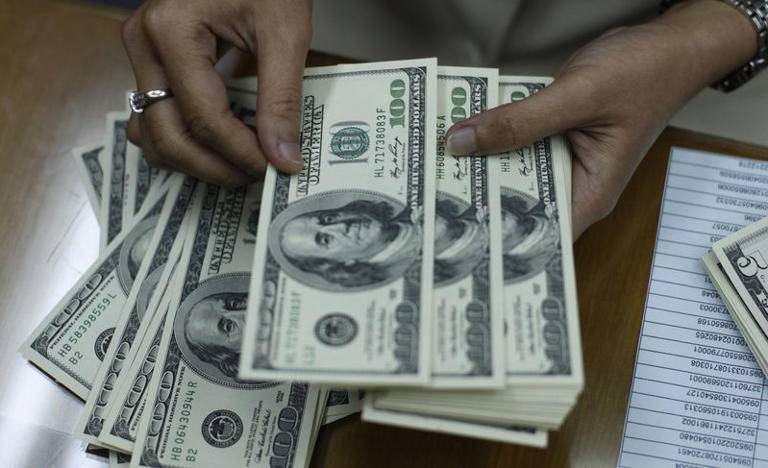On Friday, the U.S. dollar ended the trading session with minimal changes, reflecting a subdued response to recent economic data and developments. The dollar’s performance was notably influenced by a drop in Treasury yields, which followed the release of a relatively tame U.S. inflation report. This report has been pivotal in shaping market expectations for future Federal Reserve actions, particularly regarding interest rate decisions.
The Commerce Department’s latest update on the Personal Consumption Expenditures (PCE) price index revealed a modest increase of 0.1% for June. This figure was in line with market expectations and followed an unchanged reading for May. The PCE price index is a critical measure of inflation that the Federal Reserve closely monitors for its monetary policy decisions. The report suggests a steady improvement in inflationary pressures, which could potentially ease concerns about rapidly rising prices.
On a year-over-year basis, the PCE price index rose by 2.5%, slightly lower than the 2.6% increase recorded in May. This annual rate also aligned with the forecasts provided by economists surveyed by Reuters. The relatively stable inflation data could support the Federal Reserve’s policy stance, particularly as it seeks to achieve its inflation target of 2%. Lower inflation pressures could bolster confidence among Fed officials as they prepare for their next policy meeting.
Steve Englander, who heads G10 FX research at Standard Chartered Bank, pointed out that the PCE data, combined with a surprisingly strong 2.8% growth rate for Q2 GDP, had created some last-minute apprehension about potentially hotter inflation data. However, the report released on Friday provided some relief compared to the previous day’s data, which had indicated a 2.9% rise in core PCE prices. Englander commented that while the PCE data was not overwhelmingly positive, it was sufficient to reassure markets that the Fed’s upcoming September meeting would likely proceed without major disruptions. He emphasized that the Fed was unlikely to cut rates in July, and the situation would remain stable for the time being.
In the global currency markets, the Japanese yen has been a focal point, experiencing significant volatility this month. The yen surged to a near three-month high of 151.945 per dollar on Thursday, recovering from a 38-year low of 161.96 at the start of the month. This recovery is largely attributed to the Bank of Japan’s currency intervention and growing expectations that the BOJ may introduce a hawkish policy adjustment in its upcoming meeting. The Federal Open Market Committee (FOMC) is also scheduled to meet on July 30 and 31. While the FOMC is expected to maintain current interest rates, traders are anticipating potential rate cuts in September and possibly up to two more cuts later in the year.
The yield on the benchmark U.S. 10-year Treasury notes fell by 5.4 basis points, while yields on two-year notes, which are more closely tied to interest rate expectations, decreased by 5.6 basis points following the inflation report. This decline in yields reflects market speculation that the Fed might adopt a more accommodative stance in the near future.
Conversely, the Bank of Japan is anticipated to raise interest rates in its upcoming meeting, with market expectations pricing in a 64% chance of a 10 basis point increase. This potential policy shift could narrow the interest rate differential between the U.S. and Japan, impacting investment strategies that rely on the yen as a low-yielding funding currency. The increased volatility in the yen market complicates the holding of yen carry trades, though short positions in the yen continue to be attractive.
In currency trading, the dollar/yen pair weakened by 0.1% to 153.77, while the euro gained 0.13% to $1.0858. The dollar index, which measures the greenback against a basket of six major currencies, fell by 0.04% to 104.29. The British pound appreciated by 0.17% to $1.2873, although it remains below its one-year high of $1.3044 reached last week. Traders are speculating about possible rate cuts from the Bank of England during its upcoming meeting, with expectations for a total of 51 basis points in cuts this year.
Against the Swiss franc, the dollar strengthened by 0.19% to 0.8830, while the Australian dollar rose by 0.28% to $0.6556, and the New Zealand dollar increased by 0.1% to $0.5892. The dollar also saw a slight increase of 0.07% against the Chinese yuan, reaching 7.2502 yuan.
In the cryptocurrency markets, Bitcoin experienced a notable rise of 3.32%, reaching a value of $67,440.00. Ethereum also saw a significant increase of 3.17%, trading at $3,253.30. This positive movement in cryptocurrencies contrasts with the more subdued behavior observed in traditional currency and financial markets, highlighting ongoing investor interest and volatility in the digital asset space.
